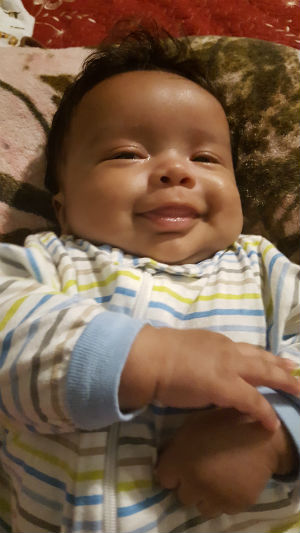
Caleb’s mom, Meryhy, was scheduled to deliver her baby via C-section on May 23, but Caleb arrived early. “On May 9th my water broke. I drove to our local hospital (in Pasadena, about 15 miles southeast of Houston), and Caleb was born that day. He seemed perfectly healthy,” says Meryhy.
Signs of Trouble
The next day, a nurse at their local hospital told Meryhy and her husband, Elias, that their baby needed oxygen and was being placed in the hospital’s neonatal intensive care unit (NICU). This scared Meryhy and Elias. A pediatric cardiologist examined Caleb and ordered tests, suspecting the baby had a congenital heart defect. An echocardiogram (diagnostic cardiac ultrasound) confirmed that Caleb suffered from a dangerous heart defect that required urgent intervention by an experienced team. Caleb was immediately transferred via Life Flight® to the Children’s Heart Institute at Children’s Memorial Hermann Hospital in the Texas Medical Center.
All of this came as a shock to Meryhy and Elias, who had no idea during Meryhy’s pregnancy that anything was wrong.
“Congenital heart defects often go undetected until after a child is born,” says pediatric and congenital heart surgeon Jorge Salazar, MD, Co-director of the Children’s Heart Institute and Professor and Chief of Pediatric & Congenital Heart Surgery at McGovern Medical School at UT Health. “Fortunately, there’s an international campaign to detect heart defects after birth. This has led to a standard practice of always checking the oxygen saturation of a baby’s blood via a simple test, called a pulse oximetry, before a baby goes home from the nursery."
Diagnosis: Obstructed Total Anomalous Pulmonary Venous Return (TAPVR)
Caleb was diagnosed with obstructed total anomalous pulmonary venous return, or TAPVR, a rare and complex heart defect in which the pulmonary veins that carry oxygen-rich blood from the lungs back to the heart are obstructed. This causes the baby to develop shock because of inadequate flow of blood and oxygen to the body, including the brain.
Tackling the Toughest Cases
Although congenital heart defects are fairly common – more than one child out of every 100 is born with a heart defect – TAPVR affects an estimated one in 10,000 children. “Despite the rarity,” says Dr. Salazar, “the Children’s Heart Institute treats 15 to 20 children a year with TAPVR. These children can be very sick with an extremely high mortality rate unless cared for at an experienced center like ours. Unfortunately, some centers shy away from operating on or caring for the most complex TAPVR cases. We don’t.”
Dr. Salazar continues, “We operated on a child recently who had TAPVR and another serious heart defect. The family had been told elsewhere, ‘There's nothing we can do,’ and the child was sent home on palliative care to pass away. After returning home, the mom, concerned, called an ambulance. It just didn't make sense to her that there was no hope. The ambulance brought the baby to us, and we fixed the baby's heart. The child is doing great.”
Successful Surgery. Amazing Recovery
Just two days after Caleb was born, Dr. Salazar, who is bilingual, explained to Caleb’s parents, in Spanish, the open-heart surgery he was about to perform to repair Caleb’s heart. During the procedure, he reconnected the abnormal veins back to the atrium. He then reconstructed the wall between the left and right atrium, called the atrial septum, so that the blood would flow to the correct side of the heart. Caleb now has a normal heart.
In preparation for surgery, Caleb was cared for in the Level IV neonatal intensive care unit and after surgery he was transitioned to the Children’s Heart Institute Intensive Care Unit (CHCICU) at Children’s Memorial Hermann Hospital. Amazingly, he went home eight days after his surgery. Today, Caleb is thriving and is expected to live a normal, healthy life.
“Our job is to give children a normal life.”
“Cases like Caleb’s tend to be very complex and very high risk,” says Dr. Salazar, “but with early diagnosis and with quick, coordinated intervention, these children can do very well. Our job is to give children back to their parents in excellent condition and with the ability to live normal, long lives. We give parents a reason to have hope, just like we would for our own children.”
Caleb’s parents are thankful for the entire team who cared for their son – the nurse who spotted his oxygen deficit, the local cardiologist who suspected the heart defect, the echo technician who helped confirm the diagnosis, the Memorial Hermann Life Flight® pediatric transport team, the surgical team, led by Dr. Salazar, and the nurses and other care providers at Children’s Memorial Hermann Hospital.
“That kind of advanced coordination,” says Dr. Salazar, “is really the secret to having the very best pediatric heart institute.”
“We thank the Lord for answering our prayers and everyone who joined us in praying for Caleb. To others in the same situation, we would say, ‘Have faith. These are dedicated people, including great doctors, who love their jobs. They are the best so don’t lose hope,’” says Elias.
Contact Us
To contact Children’s Heart Institute at Children’s Memorial Hermann Hospital, please fill out the form below.
The Children’s Heart Institute is a collaboration between the affiliated physicians at McGovern Medical School at UTHealth Houston and Children’s Memorial Hermann Hospital. Typically, patients are seen on an outpatient basis at a UT Physicians clinic with all inpatient procedures performed at Children’s Memorial Hermann Hospital.